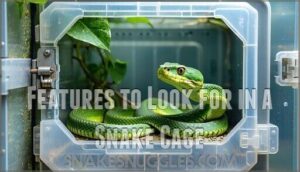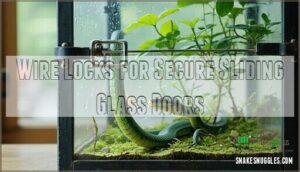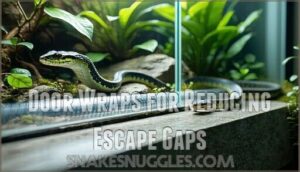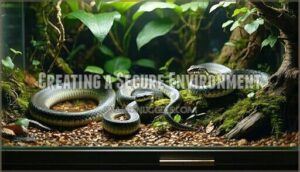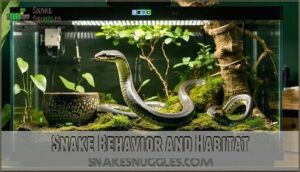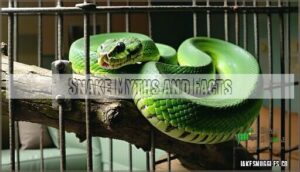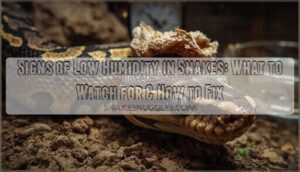This site is supported by our readers. We may earn a commission, at no cost to you, if you purchase through links.
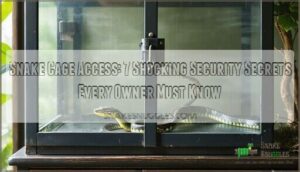
Focus on sliding glass doors with wire locks, door wraps to eliminate gaps, and solid grommets for any necessary openings. Even the craftiest snake can’t outsmart well-designed security features.
Smart sensors can alert you to unexpected door openings, while quality vision cages offer visibility without compromising containment. Remember, a bored snake is an escape artist in training.
Most escapes happen due to loose latches or worn seals that owners overlook during routine cleaning.
Table Of Contents
- Key Takeaways
- Securing Your Snake’s Home
- Choosing The Right Snake Cage
- Safety Features for Snake Enclosures
- Creating a Secure Environment
- Additional Security Measures
- Snake Cage Security Essentials
- What to Do if Your Snake Escapes
- Snake Behavior and Habitat
- Snake Myths and Facts
- Frequently Asked Questions (FAQs)
- What are the requirements for a snake enclosure?
- Can I have my snake enclosure on the floor?
- How to secure a snake cage?
- Can a snake escape a locked cage?
- How do you make a snake enclosure escape proof?
- Can I put my snake enclosure on the floor?
- What smell do snakes hate the most inside cages?
- Can snakes find their way back to cages?
- Do snakes get unhappy or stressed in small cages?
- Can you smell a snake in your house near cages?
- Conclusion
Key Takeaways
- Install double-layer security – You’ll need wire locks for sliding doors, door wraps to seal gaps, and solid grommets instead of standard ones to eliminate every possible escape route your snake might find.
- Choose quality enclosures with proven features – You should invest in vision cages with HDPE construction, tempered glass doors, and stackable designs that offer durability and clear visibility without compromising security.
- Add smart monitoring for peace of mind – You can install magnetic door alarms or smart sensors that’ll alert your phone instantly if someone opens the enclosure, giving you early warning even when you’re away.
- Maintain your setup religiously – You must inspect locks, seals, and hardware weekly, clean substrates regularly, and check ventilation monthly because most escapes happen due to overlooked maintenance issues rather than design flaws.
Securing Your Snake’s Home
When your snake decides to go on an unplanned adventure, you’ll quickly realize that "escape-proof" isn’t just marketing fluff—it’s your lifeline.
Your snake’s enclosure needs to be Fort Knox-level secure, especially if you’re dealing with venomous species where a simple "oops" could turn into a 911 call.
One careless moment with a venomous snake could be your last—security isn’t optional.
Escape-Proof Enclosures for Venomous Snakes
Venomous snake containment requires escapeproof enclosures with professional-grade security features. Don’t gamble with gaps – venomous snakes are masters at finding weaknesses.
Essential Venomous Escape Prevention features include:
- Double-Lock Systems with redundant securing mechanisms
- Thick Glass doors (tempered glass minimum)
- Solid HDPE construction eliminating seams
- Emergency Protocols with magnetic door alarms
Responsible Ownership means investing in proper snake cage security with locking mechanisms that prevent deadly mistakes. Owners should also prioritize regular enclosure maintenance to prevent escapes.
Importance of Responsibility in Snake Ownership
Responsible snake ownership isn’t just about feeding schedules—it’s about ethical considerations and public safety.
Your commitment to legal compliance directly impacts species conservation and community trust.
Here’s what separates responsible owners from the rest:
- Regular veterinary care guarantees proper health monitoring and professional guidance
- Responsible breeding practices support genetic diversity and prevent overpopulation issues
- Implementing robust snake cage security measures and escape prevention protocols protects both your pet and neighbors
Legal Considerations for Venomous Snake Owners
Before diving into security hardware, you’ll need to navigate the legal maze surrounding venomous snake ownership.
It’s not just about keeping your snake secure—it’s about keeping yourself out of legal trouble.
Category Description Why it Matters
Many owners discover these legal considerations after purchasing their snake—don’t be one of them.
Research your area’s requirements first, because proper snake enclosure security and snake escape prevention start with understanding the law.
Animal welfare experts are pushing for tighter laws on snakes kept as pets.
Choosing The Right Snake Cage
Choosing the right snake cage isn’t just about size—it’s about creating a fortress that keeps your slithery friend secure while giving you peace of mind.
The wrong enclosure can turn your pet into an escape artist faster than you can say "where’s my snake?" which directly affects your peace of mind.
Features to Look for in a Snake Cage
Several essential snake cage features can make or break your pet’s safety and your peace of mind. Solid bottoms prevent escapes through floor gaps, while secure locks stop those sneaky midnight breakouts that’ll have you searching under furniture at 3 AM.
Here are 5 must-have snake cage features:
- Solid bottoms with no gaps or weak spots
- Secure locks with reliable locking mechanisms
- Ample space for stretching and natural movement
- Proper ventilation without compromising security
- Escapeproof design with regular inspection points
Quality snake cage access means easy cleaning without sacrificing security. Look for snake cage features that prioritize snake escape prevention through thoughtful engineering rather than wishful thinking.
Benefits of Vision Cages for Reptiles
Vision Cages deliver unmatched durability advantages through single-piece HDPE construction that withstands decades of use.
You’ll appreciate the visibility benefits of tempered glass doors and cleaning ease from smooth surfaces.
These snake enclosures create a secure habitat with:
- Stackable design maximizing your space efficiency
- Aluminum vents supporting proper airflow and lighting
- Customization options for heat sources and accessories
How to Select The Right Cage for Your Snake
When you’re shopping for your snake’s new home, think of it like house hunting—location, location, location matters, but so does the foundation.
Your snake cage size should allow full body stretching plus 30% extra space.
Material matters substantially; high-density polyethylene beats glass for durability and insulation.
Prioritize ventilation needs with perforated aluminum vents to prevent respiratory issues.
Security features like wire locks and solid grommets aren’t negotiable—they’re your snake’s life insurance policy against escapes.
Safety Features for Snake Enclosures
Even the most secure-looking snake cage can become an escape artist’s dream if you overlook critical safety features that prevent your slithery friend from pulling a Houdini act.
Your enclosure’s weak points—sliding doors, gaps, and wire openings—need specific hardware upgrades to transform them from escape routes into impenetrable barriers.
Wire Locks for Secure Sliding Glass Doors
Wire locks transform sliding glass doors into secure barriers your snake can’t budge open.
These simple locking mechanisms slide between doors or adhere directly to glass, preventing even determined escape artists from pushing through.
Install them tool-free for instant snake cage security essentials.
Choose aluminum or stainless steel wire lock types for durability in humid environments, and inspect regularly for maximum snake cage escape prevention.
Understanding different wire lock applications can help you choose the best option.
Door Wraps for Reducing Escape Gaps
Beyond securing your sliding doors with wire locks, you’ll need door wraps to seal those sneaky gaps where escape artists love to squeeze through.
These wrap materials create custom barriers around door frames, blocking even the tiniest openings that determined snakes exploit. Considering different snake door wraps can substantially enhance enclosure security.
Key considerations for effective door wraps:
- Gap measurement accuracy – Measure twice, wrap once to guarantee proper coverage of all potential escape routes
- Installation techniques – Use adhesive backing or mechanical fasteners depending on your snake cage material and wrap durability needs
- Material selection – Choose vinyl, rubber, or foam strips that maintain flexibility while providing long-term escape prevention for your locking mechanism
Solid Grommets for Eliminating Escape Routes
Standard grommets often create surprising escape routes for determined snakes.
Solid grommets eliminate these gaps completely, providing superior snake cage security essentials compared to wire alternatives.
Professional installation techniques involve removing existing grommets and securing solid replacements with appropriate adhesive.
Grommet materials like rubber or plastic work best for cage modification.
Regular grommet maintenance guarantees long-term snakeproofing effectiveness.
Creating a Secure Environment
You’ll want to keep your snake’s enclosure in top condition through regular checks and maintenance—think of it as a security audit for your slithery friend’s home.
Creating the right environment isn’t just about preventing escapes; it’s about keeping your snake comfortable and stress-free, which actually makes them less likely to attempt daring breakouts in the first place.
Importance of Regular Enclosure Maintenance
Your snake’s home needs consistent upkeep to prevent dangerous security breaches and health hazards. Regular maintenance isn’t just about appearances—it’s your first line of defense against potential escapes.
A vital aspect of this involves reptile habitat maintenance, ensuring a thriving environment.
Here’s your snake cage maintenance checklist:
- Weekly substrate management – Remove waste and spot-clean soiled bedding
- Monthly ventilation checks – Clear blocked air vents and inspect airflow
- Bi-weekly equipment upkeep – Test locks, hinges, and security mechanisms
- Daily health monitoring – Watch for unusual behavior or environmental changes
Cleanliness benefits extend beyond odor control. You’re preventing bacterial growth that weakens cage materials and creates snake cage weaknesses.
Think of regular maintenance as preventive medicine—catching problems before they become costly emergencies saves you headaches later.
Ensuring a Stress-Free Environment for Your Snake
After maintaining your enclosure properly, your snake’s stress-free environment depends on thoughtful setup choices.
Enrichment Importance can’t be overstated—provide climbing branches and hiding spots where your snake feels secure.
Temperature Gradient and Humidity Control must stay consistent; fluctuations stress reptiles substantially.
Cage Size matters too—cramped quarters create anxious animals.
Think of snake cage access like designing a comfortable bedroom: proper ventilation, suitable substrate, and secure environment features work together for ideal snake stress reduction and snake safety.
Additional Security Measures
You don’t have to rely solely on basic locks and latches to keep your snake secure.
Modern technology offers smart monitoring solutions that’ll alert you the moment something’s wrong with your enclosure, giving you peace of mind whether you’re home or away.
Magnetic Door Window Alarms for Added Security
Adding magnetic door window alarms transforms your snake cage security from basic to bulletproof.
These devices instantly alert you when someone opens your enclosure, preventing snake escape disasters.
Simple alarm installation takes minutes, while remote monitoring lets you check your pet’s safety from anywhere.
You can find various magnetic door alarms online.
- Peace of mind knowing you’ll catch tampering attempts before tragedy strikes
- Sleep soundly without worrying about midnight escape attempts
- Protect your investment in expensive reptiles with early warning systems
Battery life typically lasts 12-18 months, and system integration works with most smart home setups for seamless tamper detection.
Geeni Smart Door Window Sensors for Snake Owners
Smart snake cage sensors deliver instant escape alerts straight to your phone when enclosure doors open unexpectedly.
These wireless devices offer seamless setup ease with adhesive mounting, impressive two-year battery life, and flexible sensor customization for multiple enclosures.
Remote monitoring means you’ll know immediately if your slithery escape artist attempts a breakout, even when you’re miles away from home.
Customizing Your Snake Cage for Maximum Security
Once you’ve installed smart sensors, it’s time to take snake cage access protection to the next level with custom modifications that’ll make Houdini jealous.
DIY Security upgrades transform ordinary enclosures into fortresses. Advanced Tech meets practical Material Choices when you retrofit your setup. Consider Bioactive Security features that work with living substrates while maintaining Escape Prevention protocols.
Here’s your snake cage safety features upgrade checklist:
- Reinforced door frames – Add weather stripping around snake cage locks for zero-gap sealing
- Double-barrier systems – Install backup latches behind primary snake cage escape points
- Tamper-evident seals – Use breakaway ties on access panels for immediate breach detection
- Emergency containment – Build secondary barriers around the secure environment perimeter
Regular maintenance keeps your fortress impenetrable.
Snake Cage Security Essentials
Your snake’s bedding and accessories aren’t just for comfort—they’re part of your security system that can make or break an escape attempt.
The right heat and UV-B lighting setup doesn’t just keep your snake healthy; it creates predictable behavior patterns that actually help you spot potential security weaknesses before they become problems.
Bedding and Accessories for a Secure Snake Cage
While smart monitoring systems keep watch from the outside, what goes inside your snake’s home matters just as much for security.
Think of cage accessories as your last line of defense against escapes.
Accessory Why It’s Secure Tips for Use
Your snake cage bedding shouldn’t become an escape tool. Loose substrates can pile against doors, creating gaps.
Snake cage accessories need strategic placement—nothing should create stepping stones to freedom.
Providing essential UV lighting is important for vitamin D production and overall snake health.
Remember, even the most secure environment fails if your snake cage safety features include wobbly decorations or loose fittings.
Heat and UV-B Light Sources for a Safe Environment
Your snake’s bedding sets the foundation, but snake cage heat and UVB lighting complete the security picture.
Heat lamps and radiant heat panels create proper heat gradients with basking spots reaching 85-95°F.
Install thermostat control to prevent dangerous overheating—burns compromise your snake’s health and stress levels.
UV-B intensity should hit 2.0-3.0 UVI for ideal calcium metabolism.
Position bulbs 10-14 inches above basking areas, using guards to prevent direct contact.
Maintain consistent light cycles mimicking natural patterns.
Your snake won’t just survive—it’ll thrive with proper snake temperature management.
What to Do if Your Snake Escapes
Even experienced snake owners face escape situations that test their knowledge and preparedness.
Looking at the paragraph you provided and the overall tone of the content, here’s a short, engaging blockquote:
**Every escape teaches you something new about your snake’s determination and your security gaps.
You’ll need to act quickly and systematically to safely recover your snake while identifying what went wrong with your security setup.
Why Did My Snake Escape?
Your snake escape happened because these sneaky explorers are natural Houdinis with strong escape instinct.
Common culprits include:
- Latch Failure where your supposedly secure lock gave way to determined pushing and testing
- Environmental Factors like incorrect temperatures or humidity that made home feel uncomfortable
- Cage Integrity issues such as worn seals, loose hinges, or gaps you didn’t notice during inspection
Size Matters too – if your enclosure feels cramped, your snake’s Hiding Behavior shifts to seeking better real estate elsewhere.
To prevent future incidents, owners should secure the enclosure with quality locking mechanisms. Poor lid security and door security failures account for most escapes, especially when snake containment relies on aging hardware that can’t match your pet’s persistence.
How to Prevent Future Escapes
Now that you’ve corralled your escaped snake, it’s time to play detective and identify escape root causes. Start with a thorough cage inspection – check every corner, seam, and gap that might’ve aided the great escape.
Lid security deserves special attention since loose-fitting tops cause most snake escape incidents.
Upgrade your door security with quality locks and consider mesh types that prevent tiny Houdinis from squeezing through.
Regular lock maintenance keeps your snake containment system foolproof.
Snake Behavior and Habitat
Your snake’s natural behaviors can make or break your security setup, especially since most species are nocturnal escape artists who’ll test every weakness in their enclosure while you’re sleeping.
Understanding how snakes adapt to captivity helps you create an environment that keeps them content and secure, reducing their motivation to explore beyond their cage.
Nocturnal Activity and Hiding Habits
Understanding your snake’s nocturnal nature helps you secure their snake cage effectively.
Most snakes become active after dark, exploring their environment and seeking snake hiding spots. During Activity Cycles, they’ll test snake cage door and snake cage lid security through Nocturnal Feeding behaviors and exploration. Some species even use heat-sensing pit organs to hunt in the dark.
Common nighttime locations include:
- Behind loose decorations or plants
- Under or inside hiding spots like rocks or logs
- In dark corners or against walls
- Buried in substrate like sand or soil.
Behavioral Observation during these cycles reveals Hiding Benefits and guides Environmental Enrichment decisions.
Adaptations to Captivity and Boredom Prevention
Your snake cage isn’t just a container—it’s your pet’s entire world.
Captivity stress develops when snakes can’t express natural behaviors like exploring and hunting.
Enrichment strategies combat this by rotating hiding spots, adding climbing branches, and changing substrates monthly.
These snake cage enrichment activities stimulate their cognitive abilities and prevent destructive behavioral changes.
Snake cage customization with varied textures and levels transforms boring enclosures into engaging habitats that support boredom prevention.
Snake Myths and Facts
You’ve probably heard wild stories about snakes that just aren’t true – like they’re deaf, unhappy in captivity, or lightning-fast escape artists.
Let’s separate fact from fiction so you can make smart decisions about your snake’s security needs.
Hearing and Happiness in Snakes
While your snake can’t hear conversations, it’s surprisingly tuned into your world through vibration sensitivity. These reptiles detect low-frequency sounds and vibrations through their jawbones, making them aware of footsteps and movement.
Behavioral indicators like relaxed posture and steady breathing reveal contentment.
Captivity enrichment and stress reduction techniques help debunk snake myths and facts about deafness, promoting genuine snake hearing understanding.
Speed and Smells: Debunking Common Myths
Popular movies have us believing snakes are lightning-fast predators, but snake speed reality checks that myth.
Most species can’t outrun you – they strike quickly but move slowly overall.
Their snake sense of smell through tongue-flicking is incredibly accurate, but they’re not supernatural scent detectors.
Here are key myth debunking facts about snake behavior:
- Heat pits help some species detect warm-blooded prey, not track every movement
- Speed bursts last only seconds before they tire out completely
- Strong scents like citrus actually repel most species effectively
Understanding these snake myths helps improve your snake cage security approach.
Frequently Asked Questions (FAQs)
What are the requirements for a snake enclosure?
You’ll need a secure enclosure with proper ventilation, adequate space for stretching, hiding spots, consistent temperature control, and escape-proof locking mechanisms to keep your snake safe.
Can I have my snake enclosure on the floor?
Ironically, placing your snake’s home on the ground isn’t ideal—you’ll want it elevated on a sturdy stand or table for easier access, better visibility, and protection from floor-level hazards.
How to secure a snake cage?
Choose a cage with secure locks, tight-fitting lids, and minimal gaps.
Use wire locks, door wraps, and solid grommets to seal escape routes.
Install magnetic alarms for monitoring.
Regularly inspect for weaknesses.
Can a snake escape a locked cage?
Even Houdini would struggle with proper security—snakes can escape locked cages if there’s poor lid fit, worn seals, or inadequate locking mechanisms, making regular inspections essential.
How do you make a snake enclosure escape proof?
You’ll secure your snake’s enclosure by installing proper locks, checking for gaps regularly, ensuring tight-fitting lids, using escape-proof mesh, and adding magnetic alarms for extra monitoring peace of mind.
Can I put my snake enclosure on the floor?
Yes, you can place your snake enclosure on the floor, but it’s safer elevated on a sturdy stand or table to prevent damage from spills and make cleaning easier.
What smell do snakes hate the most inside cages?
Strong chemical odors like ammonia, bleach, or citrus cleaners can stress snakes and should never be used in enclosures.
Snakes don’t naturally "hate" specific smells, but harsh chemicals irritate their sensitive respiratory systems, which is why strong chemical odors are particularly problematic.
Can snakes find their way back to cages?
Snakes can’t navigate back to their cages once they escape.
They lack the spatial memory and homing instincts that other animals possess.
Instead, they’ll wander aimlessly, seeking warmth and hiding spots.
Do snakes get unhappy or stressed in small cages?
Cramped quarters create considerable concern—you’ll definitely see stress signals when your snake’s squeezed into tight spaces.
Small cages cause behavioral changes, reduced appetite, and health problems since snakes need room to stretch, thermoregulate, and express natural behaviors, which can lead to health problems.
Can you smell a snake in your house near cages?
Healthy snakes produce minimal odor when housed properly with clean enclosures and regular maintenance. You’ll only notice strong smells if there’s poor ventilation, dirty substrate, or health issues requiring attention.
Conclusion
Like a medieval knight guarding castle gates, you must remain vigilant about snake cage access security.
Your serpent’s containment depends on quality locks, proper ventilation seals, and regular maintenance checks.
Smart sensors provide modern backup, while vision cages offer safe observation opportunities.
Remember, even the most docile snake can become an escape artist when boredom strikes.
Don’t let loose latches or worn seals turn your pet into a neighborhood surprise—consistent attention to these security details keeps everyone safe and happy.
- https://familysnake.com/guides/keeping-your-slithery-friends-secure-escapism-prevention-for-snake-enclosures/
- https://www.zenhabitats.com/blogs/reptile-care-sheets-resources/3-simple-tips-on-keeping-your-pet-snake-secure-in-a-zen-habitats-enclosure
- https://reptifiles.com/ball-python-care-guide/ball-python-terrarium-size-lighting/
- https://www.youtube.com/watch?v=7lvpDbYYUIU
- https://www.chewy.com/education/reptile-and-amphibian/snake/snake-housing

